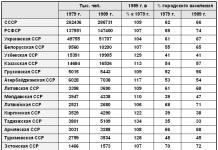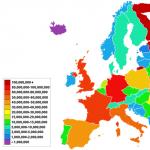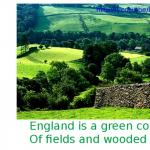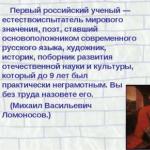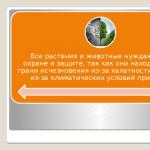ENVIRONMENT PROTECTION
Prepared by a student of grade 2 “B”
Kuznetsova Daria
Head of primary school teacher
Musatova A.N.





Fighting air pollution.
Now people are beginning to understand the harm they are causing to the environment and themselves. In order to reduce the emission of harmful gases into the air, special filters and chemical converters (catalysts) were invented. Researchers are thinking about creating new, even more modern options for protecting the atmosphere, but so far this is not enough.

Water pollution.
Liquid household and industrial waste pollutes rivers. Harmful and toxic substances absorb oxygen from the water, which is fatal to all river inhabitants.




Protection of Nature.
Many animals and plants on Earth are on the verge of complete extinction. Their habitat was destroyed by pollution, predatory deforestation, or something else. Some animals with valuable fur have become victims of excessive hunting. To save the remaining living creatures, urgent environmental measures must be taken.


The last orchid.
Some wild plants are so rare that they require special protection. So one of the types of orchids today remains only in Yorkshire (in England) and its exact location is carefully hidden.

Save the pandas

Empty seas.
For thousands of years the sea has fed man. But today, modern fishing vessels catch more fish than can reappear. Even those species that used to be so abundant (for example, cod) are on the verge of complete destruction.

Saving trees.
Forests are cut down to obtain timber and free up land for arable land and buildings. As a result, some forests were lost forever. But today, large-scale work is underway to grow new forests specifically designed to meet human economic needs.



“Human Environment” - Environmental pollution. Environment. Ecology... Nature conservation is the most important task of humanity. Content. Completed by: 10th grade student of the Studenovskaya Secondary School Skorokhod Denis. Protection of Nature.
“Land and People” - Indicate the positive and negative consequences of agricultural and industrial development in the table. When dissolved in raindrops, sulfur oxide forms sulfuric acid. How a person fought pests using scientific knowledge. Tasks for consolidation. Name environmental problems that need to be solved.
“The influence of ecology on humans” - Preparatory stage. Stages and timing of the project: During the work, you can use a booklet or presentation as illustrative examples. Protection of the obtained results and conclusions. Why do chemical pollution negatively affect human health? Excursion to reservoirs, ponds, meadows of the Lenin Spark.
“Human influence on the biosphere” - Performer: highest category biology teacher Olga Valentinovna Milyaeva Brief description of the development: Lesson on summarizing educational material. From work experience: a lesson on the topic: “Human influence on the biosphere” using ICT. Grade 11. Lesson using computer presentations. By the end of the second millennium, humanity entered a world of complex interdependencies, which in terms of scale and degree of danger have no analogues in history.
“Fundamentals of rational environmental management” - Non-metallic Min. raw materials. "Natural resources as a limiting factor for human survival." Economic. The ABC of folk wisdom. Measures for environmental protection and careful use of Russian natural resources. Carried out on the basis of permission from authorized government bodies. Plants and animals.
“Anthropogenic impact on the biosphere” - Results of impact on the hydrosphere. Sources of influence. Results of impact on the atmosphere. Anthropogenic impact on humans. Anthropogenic impact on the biosphere. Three shells of the biosphere. Red Book. Completed by: Sergey Gubchenko, student of grade 11a, Municipal Educational Institution Secondary School No. 31, Novocherkassk. Content.
There are a total of 24 presentations in the topic
Ecology... What is this?! Ecology is a science that studies the relationships between humans, flora and fauna, and the environment. Ecology is a science that studies the relationships between humans, flora and fauna, and the environment. Ecology is the science of our own home, the Earth and the laws by which we must live in it. Ecology is the science of our own home, the Earth and the laws by which we must live in it.





Assessment of pollution of natural resources The quality of water in the main large rivers of Russia is unsatisfactory. Due to the lack of treatment facilities and their unsatisfactory performance, most of the wastewater discharged by enterprises into rivers is not treated. Over the past 50 years, over 1 million hectares of arable land have been withdrawn from Russian agricultural production. The processes of soil swamping and overgrowing with shrubs have acquired dangerous proportions. Much land has been disturbed by mining, construction, road and other work.


Pollution of the environment by enterprises On the territory of Russia there are more than 24 thousand enterprises that emit harmful substances into the atmosphere and water bodies. The largest amount of emissions comes from the chemical, coal, and metallurgical industries. More than half of all emissions into the atmosphere come from transport. The situation is especially difficult in cities with a high population concentration. In Russia, 55 cities have been identified where environmental pollution reaches a very high level.

Fighting dirt Modern methods of environmental protection are based on the use of biological products, which include a variety of microorganisms that can decompose various substances, including those that pollute the Environment. Modern methods of protecting the environment are based on the use of biological products, which contain a variety of microorganisms capable of decomposing various substances, including those that pollute the Environment. They are the most numerous inhabitants of our planet... The habitat of microorganisms covers wide areas where neither plants nor animals can develop. They are the most numerous inhabitants of our planet... The habitat of microorganisms covers wide areas where neither plants nor animals can develop.







RECYCLING
(1) Recycling is a very important subject, and one that is becoming more so all the time. As we all know, it reduces waste and is good for the environment. But what do recycling centers do with the things we throw away? I found out some very interesting information.
(2) Recycling paper has been the biggest success. In 1990, in the USA, more than 20 million tons of paper were recycled and turned into birthday cards, cereal boxes, and hundreds of other things. Paper is the easiest material to recycle and, as David Dougherty ofClean Washington said, "You can use it six times over, then burn what"s left to create energy."
(3) Wisconsin cow farmer George Plenty had the most interesting use for recycled paper: he uses it instead of straw in his barn. "It"s cheaper than straw," he said, "but even if the price were the same, I wouldn"t go back."
(4) Plastic is the hardest material to recycle, because there are so many different kinds, all of which need to be treated differently. At the moment, only two per cent of the plastic used in the US is recycled. But is does have its uses: one company uses plastic from recycled car headlights to make windows. In some ways they are better than normal windows, because they are much harder to break. Another company,Image Carpets, uses plastic to make carpets and rugs. A comment made by the manager showed us how attitudes towards recycling have changed. "We're worried that people might refuse to buy the carpets if they knew they were recycled," said sales manager, John Richmeier. "Now we advertise the fact as a marketing strategy."
(5) Metal is another important material. It is easier to recycle an aluminum than to make a new one. It is also 20 per cent cheaper, and uses only 5 per cent of the energy that making a new one could use. So many of the things we use are made of metal, and can all be reused after they stop working. Recycling car parts, for example, is a big business. There is also very little waste involved in recycling metal. Steel is 100 per cent recyclable, and can be recycled hundreds of times. Recycling steel is cheaper than mining it. A lot of America's scrap metal is taken by the Japanese, recycled, and eventually sold back to America as new cars.
(6) 20 per cent of America's glass is recycled, and used for a number of things. For example, it can be mixed with asphalt or cement and used to pave streets. It can also be melted down and used to make new bottles. However, unlike the other materials, glass can also be reused commercially in its original form; many types of bottles are returned to bottling plants, sterilized and refilled glass is actually a huge worldwide business, with bottle banks appearing everywhere. .
(7) So remember, think before you throw things away - they may still be useful. If we all make an effort to recycle, we can make the planet a cleaner place to live.
View presentation content
"Environmental Protection Recovered File"
“ Our Earth is Our Home”

The environment is all the things we need to be able to live - clean water to drink, air to breathe and healthy food to eat.
We can't live without
plants and animals.
They help to make the
soil, they clean the
water and air, and they give us all our

The world is our home and we want to see it clean and beautiful.
At the same time we take from nature
as much as we can.

Every day we hear about environmental
problems:
- Waste
- Fires
- Acid rains
- Pollution
- climate change
- The destruction of rainforests
and other wild habitats

Chemical waste pollute river water, killing
wildlife .The pollution affects the health
of people and animals.
We make a lot of waste.
Some of which is TOXIC.
We pour toxic waste into
our rivers, lakes, seas and

Acid rain is rain consisting of water droplets that are unusually acidic because of atmospheric pollution .
Acid rain is a serious environmental problem
that affect s large parts of the United States
and Canada.

Forest fires are one of the greatest natural destroyers
of our forests.
Each year fires burn millions of hectares of forest all over the world.

Rainforests are very dense, warm
and wet forests.
Rainforests are found on every
continent across the Earth,
except Antarctica.
They cover only 6% of the Earth's
surface but yet they contain more
than a half of the world’s plant and animal species.

The Earth has been getting hotter because we are producing too many greenhouses gases.
Because the Earth is
getting hotter, ice is melting.
Scientists say that in 2050
some parts of Great Britain
will be under the sea.

ANIMALS IN
It is necessary to help wild animals.
Many of them are in danger now.
For example, pandas which live in the jungle and white bears which live in the Arctic.




You are going to read the text about recycling. Your task is to choose the most suitable heading for each part (1-7) of the article. There is one extra heading which you do not need to use.
A. Straw vs. paper
B. Recycled plastic
C.Reusing glass
D. Recycling metal
F. The process of recycling
G. Recycling tin cans
H. The importance of recycling
I. Recycling paper
While reading stage

Match the beginning and the ending
of the sentences.
1. Recycling is a very important subject…
2. More than 20 million tons of paper were recycled…
3. Plastic is the hardest material to recycle…
4. So many of the things we use are made of metal…
5. Steel is 100 per cent recyclable...
6. Glass can also be melted down...
a) and can all be reused after they stop working.
b) because there are so many different kinds, all of which need to be treated differently.
c) and can be recycled hundreds of times.
d) and used to make new bottles.
e) and one that is becoming more so all the time.
f) and turned into birthday cards, cereal boxes, and hundreds of other things.

Post-reading Stage Answer the following questions using the text.
- What is the problem described here?
- What is recycling?
- Why do American farmers prefer using paper to straw?
- What things can be made through the process of recycling?
- Why is recycling so important nowadays?

- We can recycle newspapers,
bottles and metal cans.
- We mustn't cut down trees.
- Feed birds in winter.
- Protect wildlife, plants and trees.
- Keep all water clean.
- Don't use aerosol sprays.
- Don't use chemicals in the garden.
- Turn off the light when you leave the room.
- Don't cut wild flowers.
- Try to avoid buying plastic. It's hard to recycle.
Environmental protection Favorable environment - environment,
quality
which
provides
sustainable
functioning of natural ecological systems,
natural and natural-anthropogenic objects.
Environmental protection - activities of bodies
state authorities of the Russian Federation, state bodies
authorities of the constituent entities of the Russian Federation, aimed at preserving and
recovery
natural
environment,
prevention
negative
impact
economic
And
other
activities on the environment and its elimination
consequences.
Public management in the field of environmental protection
environment is carried out by federal authorities
executive power Environmental Management at
regional level
To the main powers of public authorities
subjects of the Russian Federation in the field of relations related to security
environment include:
1. adoption of laws and other regulations
legal acts of a constituent entity of the Russian Federation in the field
environmental protection, as well as
exercising control over their
execution;
2. right of acceptance and implementation
regional programs in the field of protection
environment;
3. implementation of state control
in the field of environmental protection. Environmental Management
environment at the municipal level
organization of environmental protection measures within the boundaries
municipality
on waste:
urban and rural settlements
organization of collection and removal of household waste and garbage.
municipal areas
organization of recycling and recycling of household and
industrial waste. Ecology... What is this?!
Ecology is the science that studies
relationships between people
flora and fauna and
environment.
Ecology - the science of our
own home, about the Earth and laws,
according to which we must live in it.
Protection of Nature
Nature conservation is a set of conservation measures,rational use and restoration of natural
resources and environment.
Activities related to nature conservation can be
divided into the following groups:
natural sciences,
technical and production,
economic,
administrative and legal.
MAIN ENVIRONMENTAL PROBLEMS.
Environmental pollution in progresseconomic activity.
Disruption of the circulation of substances.
Changes in the earth's surface.
Protection of flora and fauna.
Main problems of natural resource protection
LandThe problem is their renewability. Prospects
use of nuclear power plants.
Water
The problem is saving water consumption and
fresh water pollution
Biological
The problem of protecting the planet's population.
Environmental pollution by enterprises
There are more than 24 thousand located on the territory of Russia.enterprises emitting harmful substances into
atmosphere and bodies of water. Largest quantity
emissions come from chemical, coal,
metallurgical industry. More
half of all emissions into the atmosphere come from
transport. Particularly difficult situation
develops in cities with high concentrations
population. In Russia allocated
55 cities where environmental pollution
reaches a very high level.
Natural resource pollution assessment
Basic water qualityof large rivers in Russia is unsatisfactory. Because of
lack of treatment facilities and
their unsatisfactory performance
most of the wastewater
discharged by enterprises into
rivers are not cleaned.
Over the past 50 years, from
agricultural turnover
Russia received over 1 million hectares
arable land. Dangerous scope
acquired waterlogging processes
soils, overgrown with shrubs. Fighting dirt
Modern ways to protect the environment
environments are based on the use of biological products,
which includes a variety of
microorganisms capable of decomposing
various substances, including those that
pollute the environment.
They are the most numerous inhabitants of our
planets... Habitat of microorganisms
covers wide areas where they cannot
neither plants nor animals develop. 1. The most polluted rivers and lakes
world - Rhine, Danube, Seine, Thames,
Tiber, Mississippi, Ohio, Volga, Don,
Dniester, Lake Ladoga, Balkhash and
etc.
2. Hydrosphere pollution
petroleum products, heavy
metals, etc.; The danger of uncontrolled change
environment demanded
decisive practical measures to protect
nature.
Such measures include:
environmental cleaning, ordering
use of chemicals, stopping
production of pesticides,
land restoration, etc., as well as
creation of nature reserves. To the red book
Rare plants and animals are included. Environmental measures are provided for in
land, forest, water and other
federal legislation.
In a number of countries, as a result of the implementation
government environmental
programs have been significantly improved
environmental quality in selected
regions (for example, as a result of long-term
and the expensive program succeeded
restore the purity and quality of water in
Great Lakes). Internationally
along with the creation of various international
organizations on specific security issues
nature, the UN Program for
environment.

